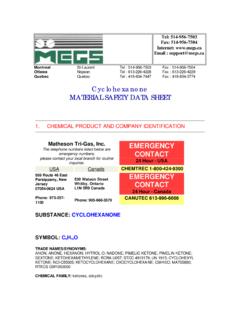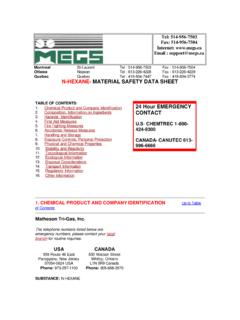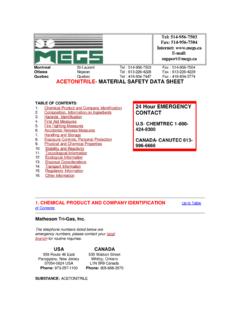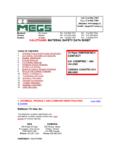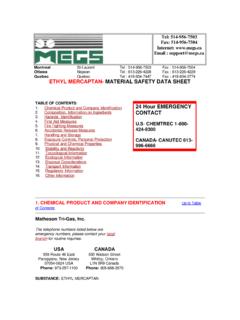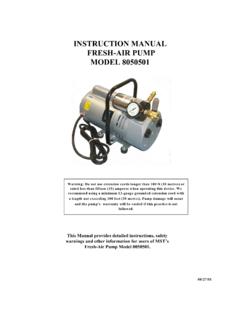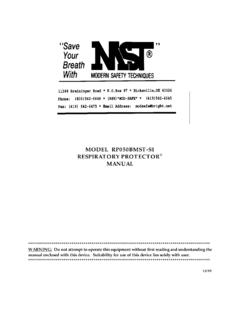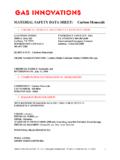Transcription of DICHLOROMETHANE- MATERIAL SAFETY DATA …
1 Tel: 514-956-7503 Fax: 514-956-7504 Internet: Email : Montreal St-Laurent Tel : 514-956-7503 Fax : 514-956-7504 Ottawa Nepean Tel : 613-226-4228 Fax : 613-226-4229 Quebec Quebec Tel : 418-834-7447 Fax : 418-834-3774 dichloromethane - MATERIAL SAFETY DATA SHEET TABLE OF CONTENTS: 1. Chemical Product and Company Identification 2. Composition, Information on Ingredients 3. Hazards Identification 4. First Aid Measures 5. Fire Fighting Measures 6. Accidental Release Measures 7. Handling and Storage 8. Exposure Controls, Personal Protection 9. Physical and Chemical Properties 10.
2 Stability and Reactivity 11. Toxicological Information 12. Ecological Information 13. Disposal Considerations 14. Transport Information 15. Regulatory Information 16. Other Information 24 Hour EMERGENCY CONTACT CHEMTREC 1-800-424-9300 CANADA- CANUTEC 613-996-6666 1. CHEMICAL PRODUCT AND COMPANY IDENTIFICATION-----------Up to Table of Contents Matheson Tri-Gas, Inc. The telephone numbers listed below are emergency numbers, please contact your local branch for routine inquiries. USA 959 Route 46 East Parsippany, New Jersey 07054-0624 USA Phone: 973-257-1100 CANADA 530 Watson Street Whitby, Ontario L1N 5R9 Canada Phone: 905-668-3570 SUBSTANCE: dichloromethane SYMBOL: CH2Cl2 TRADE NAMES/SYNONYMS: METHANE, DICHLORO-; METHYLENE CHLORIDE; METHYLENE DICHLORIDE; METHANE DICHLORIDE; METHYLENE BICHLORIDE; DMC; MC; AEROTHENE MM; NARKOTIL; SOLAESTHIN; SOLMETHINE; RCRA U080; STCC 4941132; UN 1593; CH2CL2; MAT14930; RTECS PA8050000 CHEMICAL FAMILY: halogenated, aliphatic CREATION DATE: Jan 24 1989 REVISION DATE: Mar 16 1999 2.
3 COMPOSITION, INFORMATION ON INGREDIENTS-----------Up to Table of Contents COMPONENT: dichloromethane CAS NUMBER: 75-09-2 EC NUMBER (EINECS): 200-838-9 EC INDEX NUMBER: 602-004-00-3 PERCENTAGE: 3. HAZARDS IDENTIFICATION-----------Up to Table of Contents NFPA RATINGS (SCALE 0-4): HEALTH=2 FIRE=1 REACTIVITY=0 WHMIS CLASSIFICATION: D2 EC CLASSIFICATION (ASSIGNED): Carcinogen Category 3 R 40 EC Classification may be inconsistent with independently-researched data. EMERGENCY OVERVIEW: Color: colorless Physical Form: liquid Odor: sweet odor Major Health Hazards: respiratory tract irritation, skin irritation, eye irritation, blood damage, central nervous system depression, cancer hazard (in humans) POTENTIAL HEALTH EFFECTS: INHALATION: Short Term Exposure: irritation, nausea, irregular heartbeat, headache, symptoms of drunkenness, suffocation, lung congestion, blood disorders Long Term Exposure: chest pain, reproductive effects, effects on the brain, cancer SKIN CONTACT: Short Term Exposure.
4 Same as effects reported in other routes of exposure, irritation, tingling sensation Long Term Exposure: same as effects reported in short term exposure EYE CONTACT: Short Term Exposure: irritation Long Term Exposure: same as effects reported in short term exposure INGESTION: Short Term Exposure: symptoms of drunkenness, tingling sensation, suffocation, blood disorders, kidney damage, liver damage, convulsions Long Term Exposure: no information on significant adverse effects CARCINOGEN STATUS: OSHA: Y NTP: Y IARC: Y 4. FIRST AID MEASURES-----------Up to Table of Contents INHALATION: Remove from exposure immediately.
5 Use a bag valve mask or similar device to perform artificial respiration (rescue breathing) if needed. Get medical attention. SKIN CONTACT: Remove contaminated clothing, jewelry, and shoes immediately. Wash with soap or mild detergent and large amounts of water until no evidence of chemical remains (at least 15-20 minutes). Get medical attention, if needed. EYE CONTACT: Wash eyes immediately with large amounts of water or normal saline, occasionally lifting upper and lower lids, until no evidence of chemical remains. Get medical attention immediately. INGESTION: If vomiting occurs, keep head lower than hips to help prevent aspiration.
6 Get medical attention, if needed. NOTE TO PHYSICIAN: For inhalation, consider oxygen. For ingestion, consider gastric lavage. Consider oxygen. 5. FIRE FIGHTING MEASURES-----------Up to Table of Contents FIRE AND EXPLOSION HAZARDS: Slight fire hazard. EXTINGUISHING MEDIA: carbon dioxide, regular dry chemical Large fires: Use regular foam or flood with fine water spray. FIRE FIGHTING: Cool containers with water spray until well after the fire is out. Stay away from the ends of tanks. For tank, rail car or tank truck, evacuation radius: 800 meters (1/2 mile). FLASH POINT: No data available. LOWER FLAMMABLE LIMIT: 13% UPPER FLAMMABLE LIMIT: 23% AUTOIGNITION: 1033 F (556 C) HAZARDOUS COMBUSTION PRODUCTS: Thermal decomposition products or combustion: halogenated compounds, oxides of carbon, phosgene 6.
7 ACCIDENTAL RELEASE MEASURES-----------Up to Table of Contents AIR RELEASE: Reduce vapors with water spray. SOIL RELEASE: Dig holding area such as lagoon, pond or pit for containment. Dike for later disposal. Absorb with sand or other non-combustible MATERIAL . WATER RELEASE: Trap spilled MATERIAL at bottom in deep water pockets, excavated holding areas or within sand bag barriers. Remove trapped MATERIAL with suction hoses. Subject to California Safe Drinking Water and Toxic Enforcement Act of 1986 (Proposition 65). Keep out of water supplies and sewers. OCCUPATIONAL RELEASE: Avoid heat, flames, sparks and other sources of ignition.
8 Stop leak if possible without personal risk. Small liquid spills: Absorb with sand or other non-combustible MATERIAL . Large spills: Dike for later disposal. Remove sources of ignition. Keep unnecessary people away, isolate hazard area and deny entry. Reportable Quantity (RQ): Notify Local Emergency Planning Committee and State Emergency Response Commission for release greater than or equal to RQ ( SARA Section 304). If release occurs in the and is reportable under CERCLA Section 103, notify the National Response Center at (800)424-8802 (USA) or (202)426-2675 (USA). 7. HANDLING AND STORAGE-----------Up to Table of Contents Store and handle in accordance with all current regulations and standards.
9 Protect from physical damage. Store in a cool, dry place. Store in a well-ventilated area. Avoid heat, flames, sparks and other sources of ignition. Store in a tightly closed container. Store under an inert atmosphere. Keep separated from incompatible substances. 8. EXPOSURE CONTROLS, PERSONAL PROTECTION-----------Up to Table of Contents EXPOSURE LIMITS: dichloromethane : dichloromethane (METHYLENE CHLORIDE): 25 ppm OSHA TWA 125 ppm OSHA TWA 15 minute(s) ppm OSHA action level 50 ppm (174 mg/m3) ACGIH TWA VENTILATION: Provide local exhaust or process enclosure ventilation system. Ensure compliance with applicable exposure limits.
10 EYE PROTECTION: Wear splash resistant SAFETY goggles with a faceshield. Provide an emergency eye wash fountain and quick drench shower in the immediate work area. CLOTHING: Wear appropriate chemical resistant clothing. GLOVES: Wear appropriate chemical resistant gloves. OSHA REGULATED SUBSTANCES: OSHA 29 CFR respirator : The following respirators and maximum use concentrations are drawn from NIOSH and/or OSHA. 625 ppm Any supplied - air respirator operated in a continuous-flow mode. 1250 ppm Any supplied - air respirator with a full facepiece that is operated in a pressure-demand or other positive-pressure mode.
